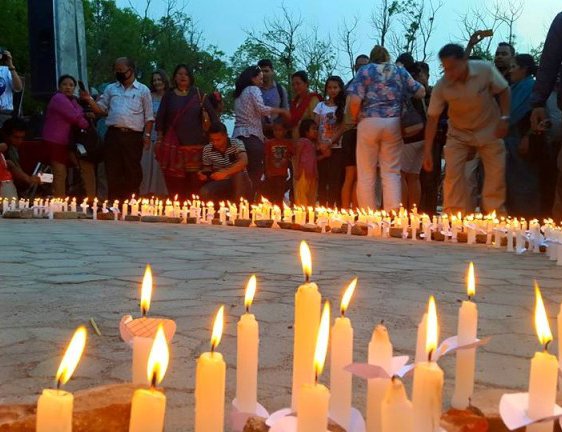
As the era of MDGs comes to an end in 2015, how does World Vision as a child-focused development organization perceive the progress?
World Vision shares the same perspective as many development actors. The MDGs have been the most successful global anti-poverty push in historyproducing impressive results. All of us can take pride in the fact thatevery day 14,000 fewer children die of preventable causes and that 700 million people have escaped the grip of absolute poverty. As a child-focused development organization, World Vision joined hands with United Nation’s Every Women Every Child, a global strategy to improve women and children’s health to achieve some of the MDG targets. Globally, World Vision committedUS$1.5 billion over a period of five years in support of a family and community model of health care delivery, focusing on a health and nutrition strategy, the prevention of mother-to-child transmission of HIV/AIDS and HIV/STI screening of children. Therefore we are not only witness of the progress but also the partners of this significant achievement.
What about Nepal’s progress in MDGs focusing on children’s health and education?
Nepal has made very good progress in the health sector specifically to achieve MDGs 4 and 5 which has been acknowledged by United Nations and manydevelopment partners. Nepal is a challenging context: It has endured a decade-long armed conflict and political instability, and more recently has had to focus on a major national political agenda, including peace-building, writing the constitution and state restructuring. Despite these challenges, Nepal’s achievements are remarkable. Childhood mortality declined markedly over the past 20 years, between 1990 and 2011: the infant mortality rate (IMR) declined from 108 to 46 and the under-five child mortality rate (U5MR) from 162 to 54 per 1,000 live births. Nepal has also made excellent progress in primary education: from just 64 percent in 1990, the net enrolment rate (NER) at the primary level reached 95.3 percent in 2013. Howeverthere are huge inequalities and disparities among groups based on caste/ethnicity, ecological region, geographical region and wealth quintile. Historically marginalized and disadvantaged communities have been left behind the more privileged communities in the development process.
So what would be the role of World Vision in ensuring goals related to children after the MDGs come to an end?
One of the principal weaknesses of the MDGs was the lack of a roadmap for delivery of the goals. Ending extreme poverty will not be possible if we continue business as usual: innovative approaches are needed. The post-2015 process must make provisions for how the new thematic goals will be achieved, and how they will be monitored and reviewed.The framework must promote participatory monitoring and accountability mechanisms at all levels. World Vision is developing cross-sector partnerships with governments; multilateralorganisations, business and civil society can foster innovations to speed and scale delivery of the new goals. So as an organization World Vision is lobbyingwith governments to ensure that children are at the centre in post-2015 goals for sustainable development.
What is World Vision’s recommendation for the post MDG goals?
World Vision has come up with specific recommendations for the post-2015 framework that replaces the Millennium Development Goals (MDGs)and its success must be measured by its ability to reach the most disadvantaged and vulnerable children in the hardest places to live.World Vision calls on member states to ensure that the post 2015 development framework
· Prioritiseschildren’s health and development, including goals and targets to end preventable maternal, newborn and child deaths; eliminating childhood malnutrition and; ending all forms of violence against girls and boys
· Focuses on the most vulnerable and the hardest-to-reach by targeting children in fragile and conflict -affected contexts, including through a goal to achieve lasting peace and eliminate violence
· Delivers a strong system for implementation, monitoring and evaluation of the new development goals, with the participation of citizens at all levels and multi-stakeholder platforms to support national implementation
Is there anything you would like to share with civil society and the government of Nepal?
World Vision International Nepal is working with other civil society organizations to lobby with the government and political leaders of Nepal so that the post-MDG framework puts children at the centre. Based on the achievement and learning of MDGs, the Government of Nepal could be a champion to lead the maternal and child agenda at the international arena in the upcoming negotiations forthe Sustainable Development Goals. As you know the SAARC summit is going to be held in Nepal on 26 and 27 November 2013, it will provide a forum for Nepal to take leadership on children’s agendas even at the regional level. Therefore I like to encourage the government of Nepalto start the discourse in the SAARC summit putting children at centre. World Vision International Nepalis willing to collaborate with others stakeholders who are interested in taking the agenda of children forward for sustainable development.
- TANAHU HYDROPOWER PROEJCT: A Significant Achievement
- Apr 15, 2024
- AMBASSADOR HANAN GODAR: Sharing Pain With A Nepali Family
- Mar 30, 2024
- VISIT OF KfW AND EIB TO NEPAL : Mission Matters
- Mar 25, 2024
- NEPAL BRITAIN SOCIETY: Pratima Pande's Leadership
- Mar 24, 2024
- NEPAL ARMY DAY: Time To Recall Glory
- Mar 15, 2024
















